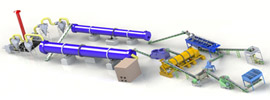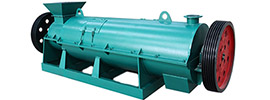The production process of mushroom residue organic fertilizer is a comprehensive utilization of agricultural waste and a process of resource recycling. Its core lies in transforming mushroom residue into fertilizer rich in organic matter and nutrients through microbial fermentation technology. Below is a detailed description of this process and its technical key points:
I. Raw Material Preprocessing Stage
- Cleaning and Crushing
- Impurity Removal: Eliminate polyethylene packaging bags, soil clods, stones, and other impurities from the mushroom residue to prevent any negative impact on fermentation efficiency.
- Crushing: Reduce the mushroom residue to a particle size below 5mm to increase the surface area of the material and accelerate microbial decomposition. For instance, the patent technology of Zhushan County Lvgu Edible Fungi Co., Ltd. explicitly requires controlling the crushing particle size within this range.
- Mixing and Proportioning
- Carbon-Nitrogen Ratio Adjustment: The carbon-nitrogen ratio (C/N) of mushroom residue is relatively high (typically above 30:1). It is necessary to add livestock manure (such as chicken or pig manure), urea, or other nitrogen-rich materials to adjust the C/N ratio to 25:1-30:1, balancing the nutritional needs of microorganisms.
- Auxiliary Material Selection: Mix with straw, sawdust, rice husks, etc., to increase porosity, or add silt and biogas slurry to enhance nutrient diversity.
II. Fermentation Treatment Stage
- Moisture Adjustment
- Maintain the moisture content at 50%-65%. A simple judgment standard is that when the material is grabbed by hand, water marks should be visible without dripping, and the material should scatter upon landing. Too low moisture slows down fermentation, while excessive moisture impairs aeration.
- Inoculation of Microbial Agents
- Add microbial fermentation agents (such as thermophilic actinomycetes or composite agents), generally at a rate of 1kg agent for every 200-500kg of mushroom residue. These agents accelerate the decomposition of organic matter and inhibit pathogens.
- Pile Fermentation
- Pile Construction: Form the material into windrows (2m wide, 1m high) and cover with plastic film for insulation and moisture retention.
- Turning and Temperature Control: Turn the pile when the temperature rises to 65℃, and repeat the turning process each time the temperature drops to 50℃. Frequent turning is necessary to prevent the pile temperature from exceeding 70℃. The high-temperature phase should be maintained for over 15 days to eliminate pathogens and eggs.
- Fermentation Cycle: Typically lasts 15-30 days, which may extend to 40-60 days under low winter temperatures.
III. Maturation and Post-Treatment Stage
- Secondary Curing
- After fermentation, move the material to a ventilated and dry place for 20-30 days to further stabilize the organic matter and reduce the risk of seedling burning.
- Quality Inspection
- Maturity Indicators:
- Carbon-nitrogen ratio (C/N) reduced to 19-21;
- Seed germination index (GI) > 80% (tested according to NY/T 3442-2019 standard);
- The material should be brown to dark brown, free of foul odor, and without fly larvae.
IV. Finished Product Processing Stage
- Crushing and Sieving
- Use a sieving machine to remove large particle impurities, with the qualified product particle size typically being less than 5mm.
- Granulation
- Produce granular organic fertilizer using an extrusion granulator or a spray granulator according to market demand, or maintain it in powder form. Granular fertilizer is convenient for mechanical application, while powdered fertilizer is suitable for base fertilizer.
- Drying and Packaging
- Dry the granular or powdered organic fertilizer to a moisture content below 20%, followed by automated packaging, generally in 25kg or 50kg bags.
V. Equipment and Production Line Configuration
- Main Equipment: Crushers, mixers, turners, sieving machines, granulators, dryers, coolers, packaging machines, etc.
- Production Line Scale:
- Small-scale plants: Annual output of 10,000-40,000 tons, with lower investment, suitable for start-ups.
- Medium-scale plants: Annual output of 50,000-80,000 tons, with increased equipment automation.
- Large-scale plants: Annual output of 90,000-150,000 tons, equipped with intelligent control systems for higher efficiency.
VI. Technical Advantages and Application Effects
- Long-lasting Fertilizer Efficiency: The slow decomposition of lignocellulose provides sustained nutrient release and improves soil structure.
- Soil Improvement: Enhances soil porosity, permeability, beneficial bacteria, and microbial populations, alleviating soil compaction.
- Environmental Safety: High-temperature fermentation inactivates over 99% of pathogens and eggs, with a mushroom residue utilization rate exceeding 95%.
- Application Effects:
- After application to tomatoes, nitrate content decreases, while soluble sugar and vitamin C contents significantly increase.
- After application to potatoes, soil pH, organic matter content, and crop yield are significantly improved.
Through the above process, mushroom residue organic fertilizer not only realizes the resource utilization of agricultural waste but also provides an efficient and environmentally friendly fertilizer solution for sustainable agriculture.
 Send us a Email
Send us a Email Wulong Industrial Cluster
Wulong Industrial Cluster Have any question?
Have any question?



















